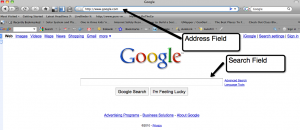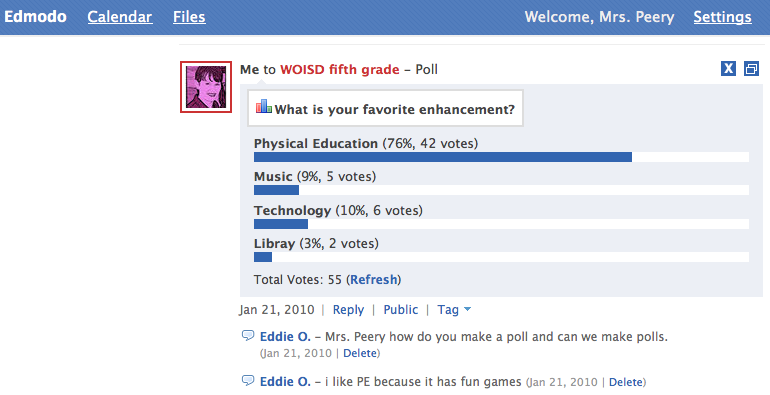I have registered White Oak Intermediate School to participate in Google’s contest to design a logo with the theme, “If I could do anything, I would…” The contest rules allow each school to submit up to six entries. I would love to have two entries from each of the three grade levels…3rd, 4th, and 5th. The winning entry receives a $15,000 college scholarship and $25,000 worth of computer equipment for their school. I know the winning entry could very well be within our own walls, so come on students! Take an 8 1/2 x 11 sheet of paper, some crayons, markers, or use a computer drawing program and try your hand at designing the winning logo. Designs must be submitted by March 31st, so let’s get drawing! Submit your drawings to Mrs. Peery. For more information, click on the picture above.
Third Grade Wax Museum
Through the hard work and direction of third grade teacher Stephanie Hunter, thirty-one third graders have completed and presented to the community their research on famous people by posing “in character” for a wax museum. The museum was open to the public Friday, March 5, 2010. Parents, teachers, students and community members came out in great numbers to see the famous people. Students worked hard to research important information about their chosen person. They took that information and created a speech which they recorded in the computer lab using a Blue Snowball microphone. Their speeches were downloaded to iPods and computers for patrons to listen to as they went through the museum. You can enjoy the characters and their speeches presented in the glogster poster below.
Artistic Problem Solving
While going through my Google Reader tonight, I came across this site that caught my attention. After watching the video embedded below, I decided to download the demo and have my 4th grader give it a try. I am personally not very good at this type of thing, but my son loves the challenge. If it is as good as it looks, I may be willing to spend the $19.95 the full version costs. Unfortunately, it requires a PC using Windows Vista or XP. The creator may make a version for the Mac, but he doesn’t make any promises.
Crayon Physics Deluxe from Petri Purho on Vimeo.
Here We Go, Animoto!
I just signed up for a new educational Animoto account. When I was at the TCEA Convention in Austin a few weeks ago, I saw a presenter demonstrate a book review by a student using Animoto. The fourth graders are working on their summary skills, so I thought this would be a good opportunity to let them try out Animoto. I am currently debating on setting up their own accounts using an extended email address, or setting up an account for each computer in the lab. The third graders have just finished researching their famous person, so I may let them try it out as well. They have saved several pictures to their flash drives. Using Keynote or Pages, they could type in large font relevant information from their research and save the pages as jpg files, or screen capture the pages to upload to Animoto. Below is the Animoto I created from the pictures and video taken during the week at TCEA 2010 in Austin.
Edmodo Rocks!
I came across this wonderful tutorial demonstrating how to use the social networking site for educators called Edmodo. I have been using Edmodo with the fifth graders for a few weeks now. The students love to communicate with one another. We have also completed polls and are learning how to use the assignment feature. After watching the video, I began to realize just how powerful this social networking site could be. Check out the video and you may find Edmodo useful for your class.
Glogster Presentation at TATN in Austin
I will be in Austin the week of February 8 – 12, 2019 for the TCEA (Texas Computer Education Associaton) conference. On Tuesday, I have the priviledge of presenting the use of Glogster EDU in the classroom. Glogster EDU is a web 2.0 tool that allows students to creative interactive posters. Click on the picture below to see the presentation. (It is done using glogster posters. Follow the arrows on each poster to continue the presentation.)

To Each His/Her Own
For the first time, each grade level is doing a something completely different in the computer lab. Here is what they are up to:
3rd Grade: These students have chosen a famous person to research on the internet. They are completing a form given to them by the third grade teachers to gather important information about their famous person. When they come across an image they feel would enhance their report, they are capturing the image and saving it the their flashdrive. A group of students will take their information and create a “Wax Museum”. They will record a speech which will be placed on ipods for visitors to the museum to access as they come to each character. They will dress up like their famous person and stand still while visitors come through the museum listening to the information they have recorded about the person. The other students will create an interactive poster in Glogster, a slide show in Keynote, or a report in Pages to share with the class.
4th Grade: Fourth graders are learning how to summarize a story. Each class is divided into six groups. Each group is assigned one of the following summarization strategies from “Into the Book, Strategies for Learning”.
Summary Ball
Fortune Teller
Artistic Summary
Paper Bag Reports
Story Wheel
Somebody/Wanted/But/So
The groups find a story to apply their chosen strategy to at Storybird. Each groups fills out a form that has their group number, the member names, their chosen strategy, and the Storybird story they picked. I created a user account on Storybird so I could put each group’s story in my Reading List for easy access. This week, the groups will present their strategy to the class. A member of the team will flip video the presentation. After all five classes have completed their presentations, the best presentation for each strategy will be posted on this blog.
5th Grade: The fifth graders are learning about social media by using the social networking site created for educators called Edmodo. I am really enjoying connecting with the students in this way. Right now, it is a novelty to them. They are obviously enjoying making posts, uploading their profile pictures, and replying to their classmate’s post. I am really enjoying reading the conversation and connecting with my students outside the classroom. I am new to the site also, so I have not discovered everything I may be able to use it for. One feature I do like is the ease at which I can create polls and get the students to vote. The students came up with their own poll questions last week, and I have posted them to Edmodo. Students will vote this week. When all the students have voted, they will take the results of the polls and create a Wordle using the advanced feature. The resulting Wordle will be called “Profile of a WO Intermediate 5th Grader.” I will post the resuling Wordle when it is completed.
Here is what one of the polls looks like:
Internet Search Strategies
This week students will be learn strategies for searching the internet. A common misunderstanding I see with students in the computer lab is the confusion over the address field and the search field. The address field is used when the specific web address is known. The search field is used when a specific web site is not know, but a search of websites containing the desired information is required.

Students will watch the Common Craft video called Web Search in Plain English as an introduction to the topic. Students will understand learning to search the web more effectively is important for two reasons:
1) As they get older they will encounter more opportunities and assignments that required them to find information on the internet.
2) Every day, more and more content is being added to the internet so there are more results to look through.
The common craft video does an excellent job of explaining how a search engine scans each web page for the word(s) a person places in the search field. Students will learn how the search is defined when quotes (“”) are placed around the words. They will also learn how the use of operators like AND, OR, NOT affect the search. Students will look at the Boolean Machine to visualize how the operands work. They will also use the Boolify Project to demonstrate the affect on web results.
Finally, students may work independently or in pairs to find the answers to the Internet Scavenger Hunt. Students will receive a ticket for each correct answer for the raquetball drawing for this six weeks.
Merry Christmas
Student Christmas Greetings
 |
| Make a Smilebox slideshow |
The Smilebox above is a slideshow of all the drawings students created using the drawing programs below. Merry Christmas to all!


